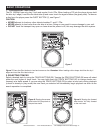
7. PITCH PERCENTAGE SELECTOR - Press
this button to choose any pitch range percent-
ages of 4%, 8%, and 16%. See page 22 for more
details.
8. BOP BUTTON - During play mode, pressing
the BOP button will instantly return play to the
last set cue point without interruption of music.
Use this function to create a stutter effect.
9. (-) PITCH BEND BUTTON - The (-) pitch
bend function creates a momentary “Slow Down”
playing. This will allow you to match the beats
source. Remember, this is a momentary function.
When you remove your finger from the pitch but-
PITCH
SLIDER'S (5) pitch value. Holding down this
button will give a maximum of -16% pitch. Use
this function to slow to another playing music
source. Be sure to notice that this function is a
momentary pitch adjustment, for a more precise
adjustment use the PITCH SLIDER (5) to match
(+) PITCH BEND BUTTON - The (+) pitch
bend function creates a momentary “BUMP” in
playing. This will allow you to match the beats
source. Remember, this is a momentary function.
When you remove your finger from this button,
PITCH
SLIDER'S (5) selected pitch. Holding down this
button will give a maximum of +16% pitch.
10. RELOOP BUTTON - If a SEAMLESS LOOP
has been made (see setting a SEAMLESS LOOP
on page 20), but the CD Player is not actively in
SEAMLESS LOOP mode (a loop is not playing),
pressing the RELOOP BUTTON will instantly
reactivate the SEAMLESS LOOP mode. To exit
the loop, press the OUT BUTTON (13). LOOP
and RELOOP will appear in the LCD DISPLAY
(21) when the RELOOP function is available.
11. TEMPO LOCK FUNCTION - This button
activates the TEMPO LOCK function. This func-
tion allows you to use the PITCH SLIDER to
speed up or slow down playback speed without
altering the tonal pitch of the track. When this
function is not engaged the original tonal pitch
of the track will be altered giving you the "chip-
munk" effect when a track is played at a high rate
of speed, or the "James Earl Jones" effect when
a track is slowed to much.
12. JOG WHEEL/EFFECTS PLATTER - This
wheel has two functions;
A. The jog wheel will act as a frame search con-
trol when the CD is in pause or cue mode,
allowing you to set a cue point.
B. The wheel also works as a pitch bend during
playback. Turning the wheel clockwise will
increase the pitch percentage up to 100%,
and turning the wheel in the counter-clock-
wise direction will decrease the pitch per-
centage down to -100%. The pitch bend will
be determined on how long you turn the jog
wheel continuously.
13. OUT BUTTON - This button is used to set
the ending point of a loop. A loop is started by
pressing the IN button (14), and pressing the
OUT BUTTON to set the loop ending point. The
loop will continue to play until the OUT BUTTON
is pressed once again.
14. SEAMLESS LOOP IN BUTTON - “CUE ON
THE FLY” - This function allows you to set a
CUE POINT (see CUE POINT page 19) without
music interruption (“on the fly”). This button also
sets the starting point of a seamless loop (see
SEAMLESS LOOP).
15. PLAY/PAUSE BUTTON - Each press of the
causes the operation to
change from play to pause or from pause to play.
While in play mode the play LED will glow, and
while in pause mode the play LED will flash.
16. SCRATCH BUTTON - This button is used to
activate and deactivate the Scratch effect. .
17. CUE - Pressing the CUE button during play-
back immediately pauses playback and returns
the track to the last set cue point (see setting a
CUE POINT, page 19). The CUE BUTTON LED
will glow when the unit is in cue mode The LED
will also flash every time a new CUE POINT
GENERAL FUNCTIONS AND CONTROLS (Cont.) CD PLAYER
©American Audio® - www.AmericanAudio.us - CK 1000Mp3 Instruction Manual Page 10


















